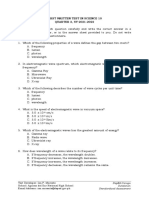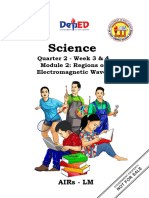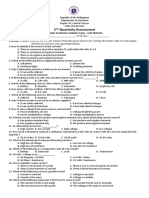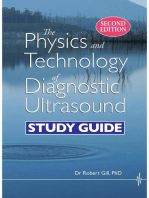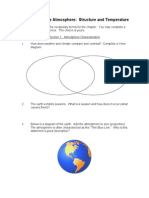Second Quarterly Examination in Science 10 SY 2022-2023
Second Quarterly Examination in Science 10 SY 2022-2023
Uploaded by
Gy FalcasantosCopyright:
Available Formats
Second Quarterly Examination in Science 10 SY 2022-2023
Second Quarterly Examination in Science 10 SY 2022-2023
Uploaded by
Gy FalcasantosOriginal Title
Copyright
Available Formats
Share this document
Did you find this document useful?
Is this content inappropriate?
Copyright:
Available Formats
Second Quarterly Examination in Science 10 SY 2022-2023
Second Quarterly Examination in Science 10 SY 2022-2023
Uploaded by
Gy FalcasantosCopyright:
Available Formats
SECOND QUARTERLY EXAMINATION IN SCIENCE 10
SY 2022-2023
Instructions: Read each question carefully and shade the correct answer in the
answer sheet provided to you. Do not write anything on this test questionnaire.
1. In electromagnetic wave spectrum, which electromagnetic wave has the highest
frequency?
A. X-ray
B. Microwave
C. Gamma Ray
D. Ultraviolet Ray
2. Which of the following describes the number of wave cycles per unit time?
A. frequency
B. lumen
C. photon
D. wavelength
3. How does wavelength of a wave relate to its frequency?
A. If frequency decreases, the wavelength doubles.
B. If frequency increases, the wavelength increases.
C. If frequency increases, the wavelength decreases.
D. If frequency decreases, the wavelength remains the same
4. The speed of light varies to the type of material it propagates. Which of following
describes this phenomenon?
A. The density of the material is directly proportional to speed of light.
B. The density of the material is inversely proportional to speed of light.
C. The opacity of a material is directly proportional to the speed of light.
D. The opacity of a material is inversely proportional to the speed of light.
5. Given the wavelength of a microwave which is 1 x 10 -3 m, what would be the
frequency if the wave travels in vacuum?
A. 2.5 x 1010 Hz
B. 3.0 x 1010 Hz
C. 2.5 x 1011 Hz
D. 3.0 x 1011 Hz
6. What happens to the speed of a wave if the frequency is doubled?
A. also doubled
B. reduced by two
C. increased by half
D. decreased by half
Test Curator: Diannah E. Divino DepEd-Caraga
School: Anolingan Integrated School Sukdanan
Email Address: diannah.erandio@deped.gov.ph Standardized Quarterly Exam
7. If an electromagnetic wave travelling in vacuum enters through a different
material, what would be its speed if it is decreased by half?
A. 1.5 x 107 m/s
B. 2.5 x 107 m/s
C. 1.5 x 108 m/s
D. 2.5 x 108 m/s
8. Considering that electromagnetic spectrum is arranged in decreasing frequency
order, what should be the 6th electromagnetic wave?
A. X-ray
B. Infrared
C. Microwave
D. Visible light
9. Consider the arrangement of electromagnetic waves: Gamma ray – X-ray –
Ultraviolet ray – Visible light – Infrared – Microwave - Radio wave, which of the
following describes the arrangement?
A. increasing energy
B. increasing frequency
C. increasing wavelength
D. decreasing wavelength
10. In terms of penetrating capacity of electromagnetic waves, which statement is
FALSE?
A. Microwave has lesser penetrating capacity compared to radio wave due to
its higher frequency.
B. Ultraviolet ray has greater penetrating capacity than infrared rays due to
its higher frequency.
C. Radio wave has the lowest penetrating capacity among all electromagnetic
waves since it has the least energy.
D. Gamma ray has the highest penetrating capacity among all electromagnetic
waves since it has the highest energy.
11. Radio waves are commonly used in long distance communication but relatively
prone to interferences. How can we minimize this kind of problem?
A. Increase reception antennas height to ensure higher detection of radio
signals.
B. Construct multiple transmissions in an area to amplify the radio wave
generation and also its wave energy.
C. Use higher frequency radio waves to increase the penetrating capacity of
the wave, thus reaches longer distances.
D. Use lower frequency radio waves to increase its energy as well as the
penetrating capacity of the wave, thus diminishing interference.
Test Curator: Diannah E. Divino DepEd-Caraga
School: Anolingan Integrated School Sukdanan
Email Address: diannah.erandio@deped.gov.ph Standardized Quarterly Exam
12. What is the common form of electromagnetic wave used by cellular phones?
A. X-ray
B. Radio wave
C. Gamma ray
D. Ultraviolet ray
13. Which of the following electromagnetic waves commonly cause visual problems?
A. X-rays
B. Infrared
C. Visible light
D. Ultraviolet ray
14. How does microwave differ from radio wave in terms of communication?
A. Microwave can transmit data in wider range than radio waves due to higher
frequency wave.
B. Microwave is more suitable in basic broadcasting since it has greater energy
than radio wave.
C. Microwave is ineffective in basic broadcasting due to its wider wavelength
than radio wave.
D. Microwave is more effective in terrestrial communication since it can pass
through atmosphere than radio waves.
15. Why can X-rays be used in investigating bone fractures?
A. Because muscle tissues absorbed more x-rays than bone structures.
B. Because X-rays with lower frequencies can pass through bones structures
and tissues.
C. Because bone structures and tissues in our body can withstand x-ray
radiation since it has lesser wavelength.
D. Because X-rays travel through the body and are absorbed in different
amounts by different tissues, depending on density of the tissues.
16. The wavelength and frequency of x-rays used in x-ray imaging can be varied in
order to study different parts of a human body. Considering the prior statement,
what will you do if you only need to observe the bone structure?
A. Increase the wavelength so that it can penetrate only in softer tissues.
B. Increase the frequency so that it can penetrate only on softer tissues.
C. Decrease the frequency so that it can penetrate in both soft and hard
tissues.
D. Decrease the wavelength so that it cannot penetrate in both soft and hard
tissues.
Test Curator: Diannah E. Divino DepEd-Caraga
School: Anolingan Integrated School Sukdanan
Email Address: diannah.erandio@deped.gov.ph Standardized Quarterly Exam
17. How will you arrange the objects present in Figure 1 below by considering the
electromagnetic wave applied in increasing wavelength order?
Figure 1. Applications of some Electromagnetic waves
(I:https://media.istockphoto.com/photos/chest-xray-scanpicture
id183931152?k=20&m=183931152&s=612x612&w=0&h=ckEktnm0breobkR8iDPHJUDIwE1lHTc2HxcCOLfDsQ,
II:https://www.tutorialspoint.com/principles_of_communication/images/fiber_optics.jpg,
III:https://femina.wwmindia.com/content/2020/oct/what-is-a-convection-microwave-oven.jpg,
IV:https://www.funkidslive.com/wp-content/uploads/2013/04/Telly.jpg )
A. IV – I – III – II
B. IV – I – II – III
C. IV – II – III – I
D. IV – III – II – II
18. Consider Figure 2 presented below, which statement is TRUE?
Figure 2. Visible Spectrum
(https://image.shutterstock.com/image-vector/visible-color-spectrum-sunlight-wavelength-260nw-
1933622132.jpg)
A. From low to high energy, the frequency decreases.
B. From low to high energy, the wavelength increases.
C. From low to high frequency, the wavelength increases.
D. From low to high frequency, the wavelength decreases.
19. Considering the following statements below, which of the following describe
ultraviolet rays?
I. cause premature aging of the skin
II. weaken the immune system
III. sanitizes medical tools and equipment
A. I and II
B. I and III
C. II and III
D. I, II and III
Test Curator: Diannah E. Divino DepEd-Caraga
School: Anolingan Integrated School Sukdanan
Email Address: diannah.erandio@deped.gov.ph Standardized Quarterly Exam
20. Microwaves travel in straight lines and are affected lightly by the troposphere.
Which of the following supports the statement above?
A. Microwaves has longer wavelength than radio wave does reaching longer
distances.
B. Microwave has higher frequency that enables it to penetrate easily in the
atmosphere.
C. Microwave has high energy that causes an increase in speed similar to the
speed of light.
D. Microwave has shorter wavelength than radio wave causes it to travel in a
straight path in vacuum.
21. In visible spectrum, the colors are relatively arranged by the amount of carried
energy. These carried energies cause change in temperature whenever absorbed
by a certain surface. How can you observe this property?
A. Ignite different colored paper and observe which paper burn faster.
B. Place different colored paper under the sun and observe which paper
changes from dark to lighter color
C. Place different colored paper under the sun and then drop small amount of
water to see if which paper gets wet.
D. Place different colored paper under a source of light and use thermometers
to measure which paper has the higher temperature.
22. After harvesting palay, farmers dry their palay in wide dryers under the sun.
This process can be uncomfortable due to hot temperature. What can you
suggest to minimize the heat experienced by the farmer while drying their
harvested crops?
A. They should wear dark-colored long sleeve clothes so that heat is easily
reflected.
B. They should wear light-colored long sleeve clothes so that less heat from
the sun is absorbed.
C. They should dry their crops during late in the afternoon so that the heat
from the sun is decreased.
D. They should wear long pants and no upper clothes so that the breeze in
the surrounding directly touch their body.
23. What form of electromagnetic wave that can only be observed by our naked eye?
A. Infrared
B. Microwave
C. Visible light
D. Ultraviolet ray
Test Curator: Diannah E. Divino DepEd-Caraga
School: Anolingan Integrated School Sukdanan
Email Address: diannah.erandio@deped.gov.ph Standardized Quarterly Exam
24. Most electromagnetic waves are harmful to human body. Which of the following
supports this statement?
A. Most of the electromagnetic waves have high radiations that can penetrate
effectively to all human tissues.
B. Most of the electromagnetic waves have high frequency than can damage
human cells due to high energy radiation.
C. Most of the electromagnetic waves have long wavelengths that can reach
longer distances affecting larger population.
D. Most of the electromagnetic waves have high frequency than can be
absorbed by human body resulting to increase in temperature.
25. Consider the statements below, which of the choices describe ultraviolet rays?
I. Commonly emitted by the sun
II. Cannot be observed by naked eye
III. Has shorter wavelength than microwave
A. I and II
B. I and III
C. II and III
D. I, II and III
26. You are the head of the security in an airport, and you have knowledge
regarding the uses of electromagnetic waves. How will you apply your knowledge
in improving the security in the airport?
A. Use ultraviolet rays to improve the CCTV camera exposure due to higher
energy of the waves detected.
B. Use different forms of x-ray to enhance the negative imaging for scanning
baggage that comes in and out the building.
C. Integrate the properties of infrared in monitoring the people inside the
airport to improve the colored videos recorded by CCTV cameras.
D. Use gamma rays in negative imaging to improve the scanning of baggage
since it has more penetrating capacity than x-rays due to higher energy.
27. Which of the following statements best describe the effect of ultraviolet ray?
A. It is emitted by the sun that travels at the same speed of light that causes
change in color pigmentation of objects.
B. It is a form of electromagnetic wave that can cause skin burn due to higher
energy radiation in comparison to visible light.
C. It is an invisible form of electromagnetic wave that can cause skin irritation
due to longer wavelengths compared to infrared.
D. It is primarily emitted by the sun and can penetrate to human tissues and
bone structures that cause temporary blindness when observed directly.
Test Curator: Diannah E. Divino DepEd-Caraga
School: Anolingan Integrated School Sukdanan
Email Address: diannah.erandio@deped.gov.ph Standardized Quarterly Exam
28. A mirror is a reflective surface which is typically made of coated glass. In which
of the following mirrors the size of the image is always smaller than the object?
A. Plane mirror
B. Silver mirror
C. Convex mirror
D. Concave mirror
29. A lens is a piece of glass or any transparent material with curve sides for
concentrating or dispersing light rays. What type of lens produces smaller and
upright images?
A. Convex lens
B. Concave lens
C. Diverging lens
D. Parabolic lens
30. What would happen to the light rays that pass through a convex lens?
A. All the light rays diverge.
B. All the light rays converge.
C. All the light rays are absorbed by the lens.
D. Some light rays diverge, and some light rays converge.
31. What type of image is produced by a concave lens?
A. It is upright and larger than the object.
B. It is upright and smaller than the object.
C. It is upside down and larger than the object.
D. It is upside down and smaller than the object.
32. What is the location of the image that is formed in a plane mirror?
A. It is at the same distance in front of the mirror as the object is in front of
the mirror.
B. It is at the same distance behind the mirror as the object is in front of the
mirror.
C. It is at a shorter distance behind the mirror than the distance the object is
in front of the mirror.
D. It is at a shorter distance in front of the mirror than the distance that the
object is in front of the mirror.
33. Which of the following statements best describe a convex mirror?
A. It forms images that are always reduced.
B. It forms images that are upright or inverted.
C. It forms images that are either real or virtual.
D. It forms images that are in front of the mirror.
Test Curator: Diannah E. Divino DepEd-Caraga
School: Anolingan Integrated School Sukdanan
Email Address: diannah.erandio@deped.gov.ph Standardized Quarterly Exam
For items 34-35, refer to Figure 3 below.
Figure 3. Image in Spherical Mirror
(Source: Science 10 Quarter 2-Module 3 Qualitative Characteristics of Image, Page 15)
34. What could be the orientation and type of your image as you look at your face
on the concave surface of the spoon?
A. The image is inverted virtual.
B. The image is upright and real.
C. The image is inverted and real.
D. The image is upright and virtual.
35. What could be your image after you bring the spoon on arm length distance
away from you using the convex surface of the spoon?
A. appears as real image
B. appears as upright image
C. appears as inverted image
D. appears as enlarged image
36. Which of the following statements best describe concave mirror?
A. Forms images that have left to right reversal
B. Forms images that are the same size as the object only
C. Forms images that are always the same distance from the mirror as the
object
D. Forms images that are either behind the mirror or on the same side as
the object
Test Curator: Diannah E. Divino DepEd-Caraga
School: Anolingan Integrated School Sukdanan
Email Address: diannah.erandio@deped.gov.ph Standardized Quarterly Exam
For items 37-38, refer to Table 1 below.
Table 1. Distance and height of Object and Image in a Plane Mirror
Object Object’s Image’s Object’s Image’s
distance from distance from height height
the mirror the mirror (cm) (cm) (cm)
(cm)
1 10 10 5.7 5.7
2 13 13 8 8
3 12 12 4 4
(Source: Learning Activity Sheets Science 10-Quarter 2-Week 6)
37. How would you compare the distance of the object and image from the mirror?
A. The distance of the object from the mirror is the same as the distance of
the image from the mirror.
B. The distance of the object from the mirror is nearer than the distance of
the image from the mirror.
C. The distance of the object from the mirror is farther than the distance of
the image from the mirror.
D. The distance of the object from the mirror is nearer while the distance of
the image from the mirror is farther.
38. Examine the data presented in the table above. What conclusion can you make
about the object and image formed in a plane mirror?
A. In a plane mirror, the distance of the object and image from the mirror is
equal. The same is true with height.
B. In a plane mirror, the distance of the object and image from the mirror is
not equal. The same is true with height.
C. In a plane mirror, the distance of the object is farther than the distance of
the image. The same is true with height.
D. In a plane mirror, the distance of the object is nearer than the distance of
the image. The same is true with height.
39. The sun’s rays are observed to focus at a point behind a lens. What kind of lens
was used?
A. Focusing lens
B. Diverging lens
C. Converging lens
D. Plano concave lens
40. Which of the following is an application of multiple image reflection?
A. Binoculars
B. Kaleidoscope
C. Magnifying glass
D. Car’s side mirrors
Test Curator: Diannah E. Divino DepEd-Caraga
School: Anolingan Integrated School Sukdanan
Email Address: diannah.erandio@deped.gov.ph Standardized Quarterly Exam
41. Rita, a medicine student, used a microscope to examine the differences between
animal and plant cells. Why do you think Rita chose a microscope?
A. because it contains mirrors that reflect images of colored glass, letting Rita
see a beautiful comparison of animal and plant cells
B. because it can focus light even at night and allow Rita to see distant
objects, it is the best choice for focusing animal and plant cells
C. because it can produce a print image by redirecting light rays at a single
point using a lens, making it easier for Rita to examine animal and plant
cells
D. because it reflects light through a mirror and bends it towards the eye
using a convex lens, letting Rita see a magnified view of an animal and
plant cell
42. Which mirror concept explains why the word AMBULANCE is written in reverse
in an ambulance car?
A. Multiple image
B. Lateral inversion
C. Lateral magnification
D. Virtual and real image
43. Reflection of light is the bouncing of light from a reflecting surface. Below,
Figure 4, shows a ray diagram of light passing a periscope.
Figure 4. Ray Diagram of a Periscope
(Source: https://56enubaterm2.weebly.com/uploads/7/8/3/9/78391106/789026179.png)
How can you explain the concepts of reflection of light using the diagram above?
A. Illuminating light reaches the specimen, which may absorb some of the
light and reflect some of the light, either in a specular or diffuse manner.
B. It works by using two lenses to focus the light and make it look like the
object is closer to you than it really is. Both lenses are in a shape that's
called 'convex'.
C. Light travels in a straight line. When light bumps into something it changes
direction. If light bumps into something shiny it reflects back in the
direction it came from.
D. The light from the object falls on one mirror at a 45-degree angle from the
object and is reflected. This reflected light then falls on another mirror and
is again reflected until it reaches the eye.
Test Curator: Diannah E. Divino DepEd-Caraga
School: Anolingan Integrated School Sukdanan
Email Address: diannah.erandio@deped.gov.ph Standardized Quarterly Exam
44. Some of the basic and fundamental parts of a camera functions just like how
the different parts of our eyes work. Which of the following parts of the eyes
function like the aperture and iris diaphragm of a camera?
A. Pupil and iris
B. Pupil and eyelid
C. Eyelid and cornea
D. Retina and cornea
45. What two forces are required for generators and electric motors to work?
A. Electric and thermal
B. Magnetic and radiant
C. Electric and magnetic
D. Magnetic and thermal
46. Which of the following is NOT the correct description of the operation of an
electric motor?
A. Electric motor uses electricity.
B. The motor converts electric energy into mechanical energy.
C. The operation is based on the principle of electromagnetism.
D. Electric motor converts mechanical energy into electrical energy.
47. Which of the following methods results in an induced voltage (or emf) by
changing the magnetic field around a conductor?
A. The faster the magnet or coil moves, the greater the amount of current that
is produced. If more turns were added to the coil or a stronger magnet were
used, this would produce more current as well.
B. Following Faraday’s Law tells us that inducing a voltage into a conductor
can be done by either passing it through a magnetic field, or by moving the
magnetic field past the conductor and that if this conductor is part of
closed circuit, an electric current will flow.
C. Shaping the electric conductor into a coil essentially increases the strength
of the magnetic field. Additionally, the more turns of the wire, the stronger
the magnetic field is produced. This is because the magnetic field produced
by each turn of wire superpose to the same center, creating a stronger
magnetic field.
D. If a coil of wire is placed in a changing magnetic field, a current will be
induced in the wire. These current flows because emf is producing an
electric field that forces the charges around the wire. A changing magnetic
field through a coil of wire therefore must induce an emf in the coil which
in turn causes current to flow.
Test Curator: Diannah E. Divino DepEd-Caraga
School: Anolingan Integrated School Sukdanan
Email Address: diannah.erandio@deped.gov.ph Standardized Quarterly Exam
48. Which is the correct sequence in the operation of generator in the production of
electricity in Hydroelectric Power Plant?
I. A turbine converts the kinetic energy of the falling water into mechanical
energy.
II. Hydropower plants capture the energy of falling water to generate
electricity.
III. Once an electrical current has been established, it is directed through
copper wires to power machine and devices.
IV. The generator converts the mechanical energy from the turbine into
electrical energy.
A. I, IV, II, III
B. II, I, IV, III
C. IV, I, III, II
D. III, II, IV, I
49. What would happen to the coiled wire in an electric motor model if there is a
repulsion and attraction of the magnetic poles?
A. The coil remains stable.
B. The coil stops and changes mechanical energy into electrical energy.
C. The coil rotates and changes electrical energy into mechanical energy.
D. The coil fluctuates and converts electrical energy into chemical energy.
50. Predict what will happen to the current-carrying coil of the wire inside the
magnetic field of the permanent magnet in the diagram of a simple electric
motor?
Figure 5. Simple electric motor
(Source:https://csg.tinkercad.com/things/chbvsDftufG/t725.png?rev=226&s=&v=0)
A. Current-carrying wire will not move.
B. Current-carrying wire will fluctuate.
C. Current-carrying wire will rotate because it will interact with the magnetic
field of the permanent magnet.
D. Current-carrying wire will not rotate because it will not interact with the
magnetic field of the permanent magnet.
Test Curator: Diannah E. Divino DepEd-Caraga
School: Anolingan Integrated School Sukdanan
Email Address: diannah.erandio@deped.gov.ph Standardized Quarterly Exam
You might also like
- 3000 HWDocument391 pages3000 HWNguyễnHoàngDanh100% (1)
- S10 Q2 ReviewerDocument12 pagesS10 Q2 ReviewerApril JadeNo ratings yet
- S10 - Q2 - Answer Key 2Document6 pagesS10 - Q2 - Answer Key 2rm9qxhyrh6No ratings yet
- Answer Key For 2nd Quarterly Exam - SCIENCE10Document9 pagesAnswer Key For 2nd Quarterly Exam - SCIENCE10Donna T. Duaso100% (1)
- S10 - Q2 - Summative Test 1Document5 pagesS10 - Q2 - Summative Test 1Letsirk Saluta Ramos100% (1)
- ReviewerDocument3 pagesReviewerZelle Miyazaki100% (1)
- AnswerKey Mathematics10Document2 pagesAnswerKey Mathematics10reysheila.boholNo ratings yet
- MAPEH 10 Music Q2 1Document33 pagesMAPEH 10 Music Q2 1jixNo ratings yet
- Science 10 2nd GRADING ExamDocument3 pagesScience 10 2nd GRADING ExamBeaulah Yliel BaliongNo ratings yet
- Reviewer Quarter 4Document101 pagesReviewer Quarter 4Princess SamsonNo ratings yet
- Q2 Arts 10 - Module 3Document15 pagesQ2 Arts 10 - Module 3Marian GubalaneNo ratings yet
- Math 10 Q2-ExamDocument5 pagesMath 10 Q2-ExamJeric Garcia-Raut PinasNo ratings yet
- English-10 TeachersDocument11 pagesEnglish-10 Teachersuseromartin23No ratings yet
- Long Test Science 10 2nd QuarterDocument29 pagesLong Test Science 10 2nd QuarterAple RigorNo ratings yet
- Module 2Document30 pagesModule 2catherine.hipolNo ratings yet
- Sci10 q2 Second Summative TestDocument2 pagesSci10 q2 Second Summative TestAilyn Carlos-Dizon100% (1)
- English Reviewer 2nd Quarter Grade 10Document4 pagesEnglish Reviewer 2nd Quarter Grade 10kaoriae23100% (1)
- English 10 2nd ReviewedDocument8 pagesEnglish 10 2nd ReviewedShanrey MironesNo ratings yet
- Activity 13. May The Best Man WinDocument7 pagesActivity 13. May The Best Man WinAIVIE JANNELLE BEJONo ratings yet
- Science: Quarter 2 - Module 2Document26 pagesScience: Quarter 2 - Module 2Jaderick BucaoNo ratings yet
- Music: Quarter 1 - Module 1: Music of The 20 CenturyDocument27 pagesMusic: Quarter 1 - Module 1: Music of The 20 CenturyBadeth AblaoNo ratings yet
- English 10 - Quarter 2 - Week 7 - Direct and Indirect Speech QAedDocument14 pagesEnglish 10 - Quarter 2 - Week 7 - Direct and Indirect Speech QAedJoanabel JoaquinNo ratings yet
- WT-Q2-Arts10-Wk2-5 (Module2)Document3 pagesWT-Q2-Arts10-Wk2-5 (Module2)Mary CrisNo ratings yet
- Health 10 Learning MaterialDocument36 pagesHealth 10 Learning MaterialEvaMarieEsperaNo ratings yet
- SCIENCE 10 Q2 Module 6Document32 pagesSCIENCE 10 Q2 Module 6caballerocharisse200316No ratings yet
- MAPEH-10 PHysical-Education MODULE InteventionDocument26 pagesMAPEH-10 PHysical-Education MODULE Inteventiongloria tolentino100% (1)
- g10 Africa Musical InstrumentDocument58 pagesg10 Africa Musical InstrumentHyzel Faith ParanNo ratings yet
- q2 Math NotesDocument3 pagesq2 Math NotesFranz Gabriel GuevarraNo ratings yet
- Final LAS Science 10 Q2 W1Document11 pagesFinal LAS Science 10 Q2 W1Melogen LabradorNo ratings yet
- Science 10 - Q2 - M9Document12 pagesScience 10 - Q2 - M9John Edmund PachecoNo ratings yet
- Q2-PPT-PE10-Module1.2 (Running As Exercise)Document30 pagesQ2-PPT-PE10-Module1.2 (Running As Exercise)Gericho MarianoNo ratings yet
- Science 10 ReviewDocument3 pagesScience 10 ReviewMarl Rina EsperanzaNo ratings yet
- Module 5Document19 pagesModule 5catherine.hipolNo ratings yet
- B. Balance The Amount of Food You Eat With Regular Physical ActivityDocument2 pagesB. Balance The Amount of Food You Eat With Regular Physical ActivityJovelyn TakilidNo ratings yet
- Health10 - Q1 - Module1b (FOR TEACHER)Document26 pagesHealth10 - Q1 - Module1b (FOR TEACHER)AshleyNo ratings yet
- 10 2 / Electricty 9-DAY - : What You Need: Clean Sheet of Paper and Ballpen What You Have To DoDocument4 pages10 2 / Electricty 9-DAY - : What You Need: Clean Sheet of Paper and Ballpen What You Have To DohakkensNo ratings yet
- Quarter 2 Lesson 1 in Arts 10Document17 pagesQuarter 2 Lesson 1 in Arts 10milk teaNo ratings yet
- Arts 10 Q2 Module 2Document17 pagesArts 10 Q2 Module 2Niño John BalucaNo ratings yet
- S10 - Q2 - Week 2Document7 pagesS10 - Q2 - Week 2Evefel Ruth SanchezNo ratings yet
- 1Q Exam in Mapeh 10Document4 pages1Q Exam in Mapeh 10Dianne Mae DagaNo ratings yet
- English Week 3Document8 pagesEnglish Week 3Desiree Anne Balisi CuregNo ratings yet
- A4 Science 10 WEEK 2 Qtr. 2 2020-2021Document5 pagesA4 Science 10 WEEK 2 Qtr. 2 2020-2021ANDREW SALUNDAGUIT100% (1)
- Second Quarter Periodical Test - ElectronicsDocument3 pagesSecond Quarter Periodical Test - ElectronicsBuenavides P. Gerundio Jr.100% (1)
- Mapeh 9, RmyaDocument72 pagesMapeh 9, RmyaFrancisco ManabatNo ratings yet
- English Week 4Document7 pagesEnglish Week 4Desiree Anne Balisi CuregNo ratings yet
- Soal PISA 2012 PDFDocument76 pagesSoal PISA 2012 PDFsadamNo ratings yet
- Math10 Q2 Module4 PDFDocument26 pagesMath10 Q2 Module4 PDFzenqdumbasfNo ratings yet
- Science 9 q1 Mod5 Ecosystem Life EnergyDocument38 pagesScience 9 q1 Mod5 Ecosystem Life EnergyERVIN DANCANo ratings yet
- Science9 - Q4 - W1 - Projectile-Motion - Carlos-E.-Del-Rosario-Jr.-EDITED-May-1-2021Document15 pagesScience9 - Q4 - W1 - Projectile-Motion - Carlos-E.-Del-Rosario-Jr.-EDITED-May-1-2021Jello PanaguitonNo ratings yet
- Sci10 2nd Quarter Module 5 NO ANSWER KEYDocument18 pagesSci10 2nd Quarter Module 5 NO ANSWER KEYjhunjhun zambrano100% (1)
- Explore: Activity 1: Lag Time!Document3 pagesExplore: Activity 1: Lag Time!Maxine ReyesNo ratings yet
- PE 10 Q2 M3-ModifiedDocument14 pagesPE 10 Q2 M3-ModifiedJubilo , Daniella Mae S.No ratings yet
- Module 1Document16 pagesModule 1catherine.hipol100% (1)
- Health: Quarter 2 - Module 2aDocument21 pagesHealth: Quarter 2 - Module 2aMarlon C. ManaloNo ratings yet
- Statement of Opinion and AssertionDocument2 pagesStatement of Opinion and AssertionRaizza Camille MarasiganNo ratings yet
- Sci10 Q2 M4 EditedaftercontentlayoutlanguageevaluationDocument37 pagesSci10 Q2 M4 EditedaftercontentlayoutlanguageevaluationAqua AvilaNo ratings yet
- SCIENCE Grade 10: Quarter 2 - Module 4 Effects of Electromagnetic RadiationDocument15 pagesSCIENCE Grade 10: Quarter 2 - Module 4 Effects of Electromagnetic RadiationLenb AntonioNo ratings yet
- Q2 Week 3 SCiEd Staying Connected in Education New Normal Commun Ication EssentialsDocument59 pagesQ2 Week 3 SCiEd Staying Connected in Education New Normal Commun Ication EssentialsJoshua RealonNo ratings yet
- English 10 Q2 M8 1Document13 pagesEnglish 10 Q2 M8 1mark josephNo ratings yet
- TQ For 2nd Quarterly Exam G10 Edited v.1.1Document9 pagesTQ For 2nd Quarterly Exam G10 Edited v.1.1Resilda CuaresNo ratings yet
- The Physics and Technology of Diagnostic Ultrasound: Study Guide (Second Edition)From EverandThe Physics and Technology of Diagnostic Ultrasound: Study Guide (Second Edition)No ratings yet
- Sign Up For My Newsletter and Get A Free Science Resource!: 2019 CatcorgaDocument4 pagesSign Up For My Newsletter and Get A Free Science Resource!: 2019 CatcorgaGy FalcasantosNo ratings yet
- Invasive SpeciesDocument5 pagesInvasive SpeciesGy FalcasantosNo ratings yet
- EDER FM MSU IIT ACAD 017 Nomination of Members of Advisory PanelDocument1 pageEDER FM MSU IIT ACAD 017 Nomination of Members of Advisory PanelGy FalcasantosNo ratings yet
- MedicalCert UNDAYOY 092419Document2 pagesMedicalCert UNDAYOY 092419Gy FalcasantosNo ratings yet
- 2023 Gallery of Athletes - SecondaryDocument6 pages2023 Gallery of Athletes - SecondaryGy FalcasantosNo ratings yet
- Plasma Orbital Expansion Electrons Water FrequencyDocument140 pagesPlasma Orbital Expansion Electrons Water FrequencyVincent J. Cataldi100% (1)
- Sumnative Test Sound Waves, Light, EnergyDocument7 pagesSumnative Test Sound Waves, Light, EnergyNurul FadhilahNo ratings yet
- Science 10 2nd Quarter Lesson SummaryDocument3 pagesScience 10 2nd Quarter Lesson SummaryAbigail CastroNo ratings yet
- Nuclear PhysicsDocument58 pagesNuclear Physicshuijing9660% (1)
- PHYSICS 9702 PAPER 1 Superposition Waves (Test 1)Document4 pagesPHYSICS 9702 PAPER 1 Superposition Waves (Test 1)Muhammad TalhaNo ratings yet
- Refraction and Speed of LightDocument54 pagesRefraction and Speed of Lightshivanshkumarsahu07No ratings yet
- Physics Report Total Internal ReflectionDocument10 pagesPhysics Report Total Internal ReflectionJASMSJS SkskdjNo ratings yet
- Qoqi 3 PDFDocument59 pagesQoqi 3 PDFlolopopo28No ratings yet
- RadiationDocument11 pagesRadiationanika tahsinNo ratings yet
- Detector: Theremino ParticleDocument24 pagesDetector: Theremino ParticleRisa Amelia VentinurNo ratings yet
- 2864 June 2005Document13 pages2864 June 2005Bin RenNo ratings yet
- Module For Climate Change Chapter 2 - Physical Processes On EarthDocument23 pagesModule For Climate Change Chapter 2 - Physical Processes On EarthAngelo CabrerosNo ratings yet
- Presentation On Ruby LaserDocument9 pagesPresentation On Ruby LaserSangyukta Das100% (1)
- Chapter 02b Available Solar RadiationDocument37 pagesChapter 02b Available Solar RadiationOmar AljohaniNo ratings yet
- A Wavefront Is The Locus of Points (Wavelets) Having The Same Phase of Oscillations. WavefrontDocument22 pagesA Wavefront Is The Locus of Points (Wavelets) Having The Same Phase of Oscillations. WavefrontJinshy VinodNo ratings yet
- Properties of Cable With Enhanced Single-Mode Fibre C40Document2 pagesProperties of Cable With Enhanced Single-Mode Fibre C40RazvaniQQQ77777No ratings yet
- ENG5Q1W6D5Document5 pagesENG5Q1W6D5Christian BautistaNo ratings yet
- Unit 2 - EM Waves - 2 MarksDocument5 pagesUnit 2 - EM Waves - 2 MarksBeschi Roach100% (1)
- Characterization Techniques in Material ScienceDocument8 pagesCharacterization Techniques in Material ScienceSandeep NagarNo ratings yet
- AV10MDocument1 pageAV10MJose RodolfoNo ratings yet
- 1.6 - Time-Resolved vs. Frequency Resolved - Chemistry LibreTextsDocument5 pages1.6 - Time-Resolved vs. Frequency Resolved - Chemistry LibreTextsAhmadulhaqNo ratings yet
- Chapter 17 Reading GuideDocument9 pagesChapter 17 Reading GuideKirsten CarlsonNo ratings yet
- Light 3 QPDocument10 pagesLight 3 QPMuhammad KalimNo ratings yet
- Radio-Photoluminescence of Silver-Doped Phosphate Glass: Pabitra AryalDocument4 pagesRadio-Photoluminescence of Silver-Doped Phosphate Glass: Pabitra Aryal수딥타사하No ratings yet
- Architecture and The Urban Environment A Vision For The New AgeDocument223 pagesArchitecture and The Urban Environment A Vision For The New AgealexituerNo ratings yet
- Chapter 38 Designing For Radiation ProtectionDocument7 pagesChapter 38 Designing For Radiation ProtectionMarjorie BalontongNo ratings yet
- 3.2.2.2 Collisions of Electrons With Atoms 45336Document38 pages3.2.2.2 Collisions of Electrons With Atoms 45336David HolmesNo ratings yet
- RPP Study MaterialDocument14 pagesRPP Study MaterialKartik SharmaNo ratings yet
- Reflection of LightDocument8 pagesReflection of LightShivani ChaurasiaNo ratings yet




